The next two years will make or break the fate of hydrogen in Japan, at least as far as the state-led hydrogen economy program plans to meet its 2030 targets.
The goal is for hydrogen-fired power generation to have a nominal but noticeable place in the national electricity mix, at 1% of the total by 2030. Instead of building new power capacity oriented on hydrogen, most of that 1%, which is equivalent to 9-10 TWh of electricity, will come from so-called co-firing. This assumes that some gas power plants will add hydrogen into their fuel mix and some coal plants will do the same with its cousin, ammonia.
The challenges were, and remain, picking the most reliable, cost-effective, and environmentally clean technology. Booming interest in the hydrogen economy has revealed a plethora of technological solutions for both H2 and ammonia.
After years of testing and R&D, it’s decision time. Supply chains from production to transport and storage to consumption must be up and running well before 2030 for Japan to hit that 1% target. Here, we review some of Japan’s current solutions in hydrogen and ammonia.

